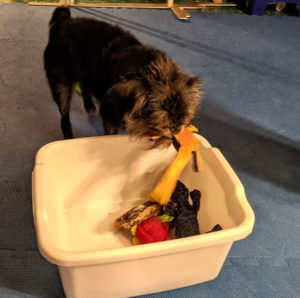Our morning habit is to have coffee, semi-wake-up, and then go down to the basement to our training area and have some fun with our dogs.
Dogs thrive on schedules
Each dog gets a turn. And, since dogs thrive with schedules, they go in the same order every day: Booker, Tango, Torque, and Simon.
It does require a little bit of mental gymnastics – what works for one dog isn’t universally true. They each have their favorite “tricks” they like to do. And, at least once a month, if we can think of one, we like to teach a new one.
It’s easy for Fran to come up with new stuff to teach Simon – he’s just a year old and most of his training so far has been spent on the fundamentals: sit, down, stay, walk nice on a leash, release cue. But recently Fran’s been expanding his repertoire with some fun tricks.
Tango knows how to put his toys away

One of the fun ones we teach is “put stuff away.” Tango’s version of this one is the cutest, since he actually puts dog toys in a bin. He’s never cared about toys, so they work fine as training tools.
It’s more problematic with the other dogs, who adore dog toys. We don’t have them lying around the house – we want our dogs to be playing with us when they have toys. So for the other dogs, we use a bunch of kitchen utensil odds and ends; spoons, strainers, ring molds, etc.
Train one “spoon” by itself
We start training with one “spoon” by itself. The same training sequence always holds:
- clicks for looking 3x
- clicks for touching with your mouth 3x
- clicks for picking it up 3x
- clicks for moving with it in your mouth 3x
- click for dropping it 3x
- Clicks for dropping it in the bin
There’s no deadline
The first day we may not even get the three “looking” clicks. That’s okay! There’s no deadline. It takes a while for dogs to understand that it’s okay to keep trying. And it may take a bit of time for the dog to figure out which part is getting the click. We have no way of knowing what dogs actually think – or how they interpret our interactions.
We started out…
We’ve been training a couple of decades now – and we learned in the bad old days when we never let a dog make a decision. And every once in a while, despite how hard we try, we fall into bad old habits. With Simon’s first try at “spoons,” he was a rock star. Whether he’d learned by watching the other dogs, it was just luck, or he somehow understands English, he got it – first time.
Resetting Fran’s brain
The test of whether a dog really knows something is whether he/she can do it again. So the next time Fran and Simon tried spoons, probably about 10 days later, he knew nothing. For whatever reason, Fran lost her mind and started saying things like “no!” when he started gnawing on the spoon – taking it from him. She put it down and started coaching him to “take it!” A quick question – “What are you doing?” stopped her in her tracks and resetting her training brain.
The old way of training was to force a dog to do something, repeatedly. Not let the dog make any mistakes, and certainly not let them choose anything. It was effective for people who could impose their iron wills on their dogs over the long term. It produced a lot of Obedience Champions.
We want our dogs to choose to abide by the rules
But it didn’t work for those of us who don’t want a permanent job watching every little thing our dogs do. We don’t want to dictate every aspect of their lives all the time. We want our dogs to be our buddies, who know the rules of the house and choose to abide by them. Just like we do.
